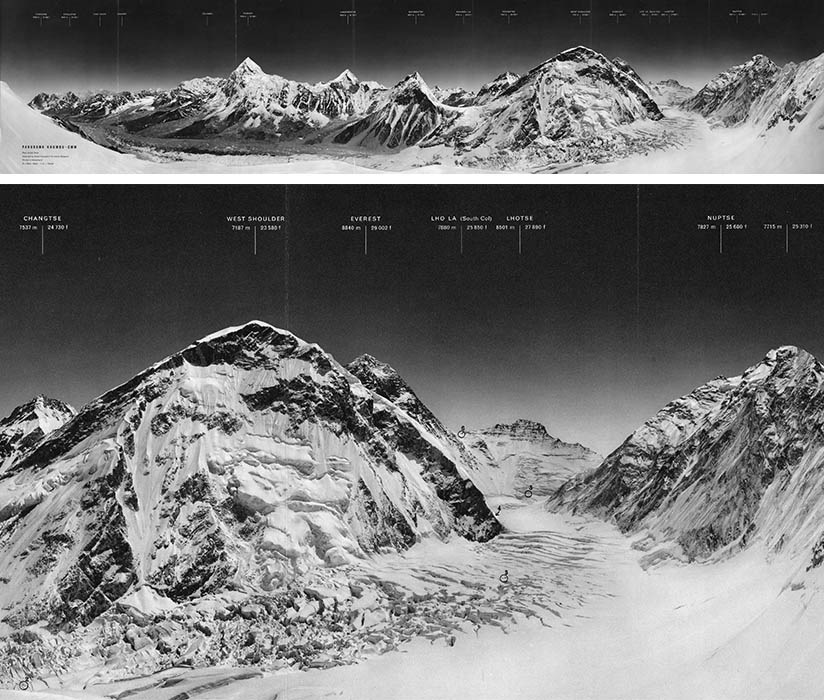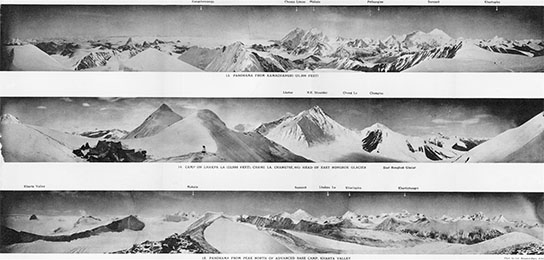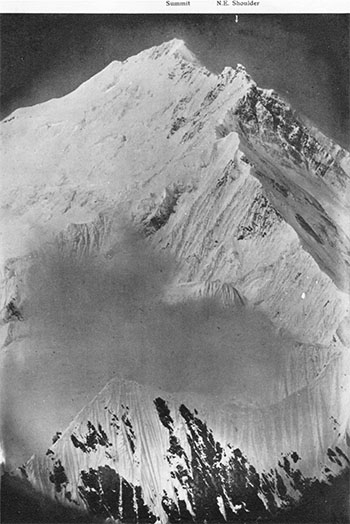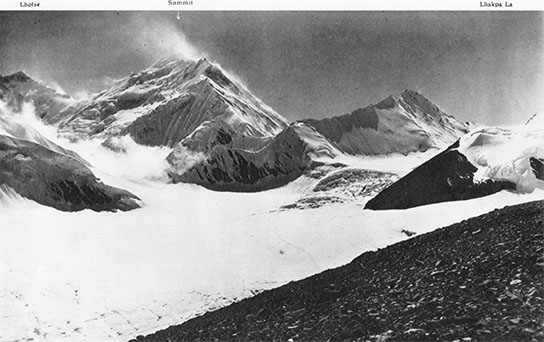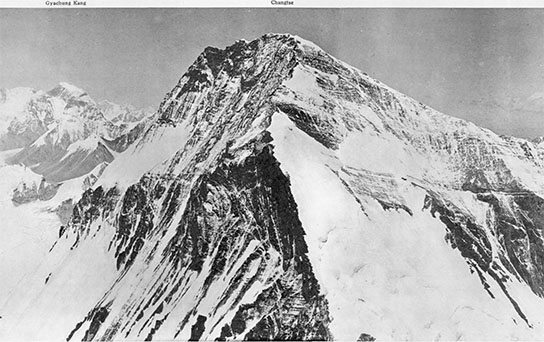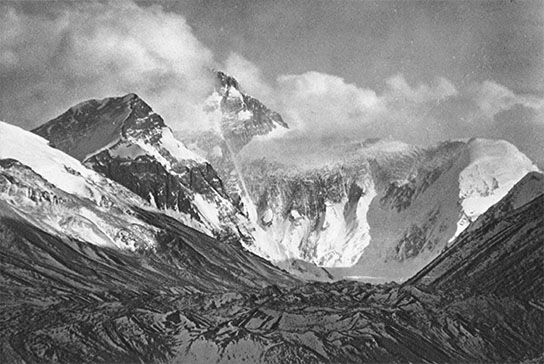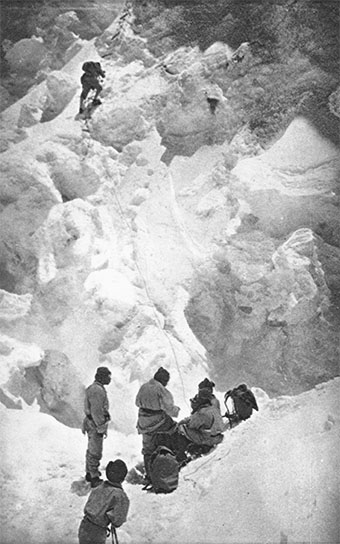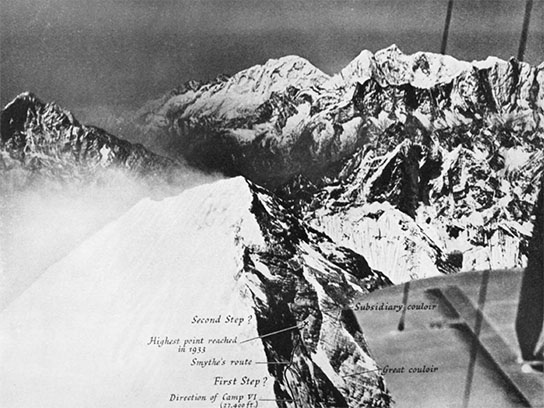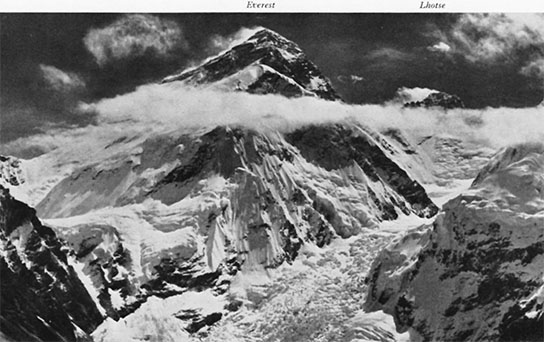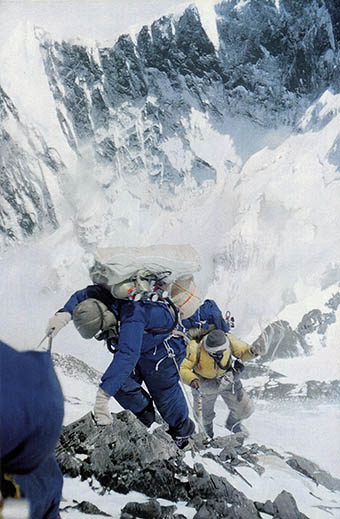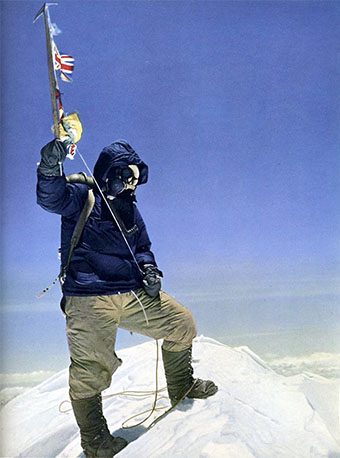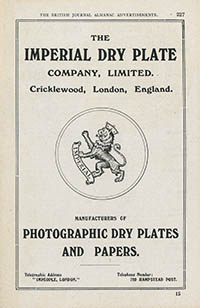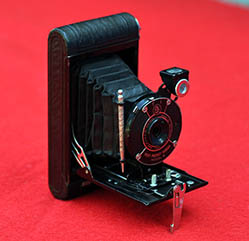118
Everest
The Early Expedition Photography
This magnificent panorama, taken by André Roch and “mounted” by H. Steiner shows the base camp and six advance camps on the South Col route used by the Swiss during their spring 1952 Everest Expedition. Although Raymond Lambert and Tenzing Norgay’s summit attempt was unsuccessful, the pair reached an altitude of 8,595m – higher than anyone had ever been on the mountain.
Norgay, of course, would return with the British Expedition the next year and the rest is history.
After a year of diplomatic negotiations the Royal Geographical Society and the Alpine Club obtained permission from the 13th Dali Lama and sent their first expedition to Everest. The 1921 reconnaissance expedition, under Col. Charles Howard-Bury, spent several months in Tibet surveying, mapping (which we covered previously), and photographing the region to find a possible northern route to the summit.
The expedition’s photographs, from dry plates2 or panoramic film, were the first close-up images of Everest ever published.3
Panoramic views
The north-east arête of Mount Everest
Wind blowing snow from the mountain
With the information gleaned from 1921 reconnaissance the British, under Charles Bruce, sent expeditions in 1922 and 1924. The official photographer was John Noel, an Army captain who resigned his commission and forfeited his pension to join the expedition. Among the 14 cameras Noel took to Everest was a specially designed 40-lb cinematograph, a glass-plate camera and several Vest-Pocket Kodaks. He even set up his own darkroom at base camp. Bruce referred to him as “St. Noel of the Cameras.”
Detail, Changtse from the North Ridge, 24,500 ft, 1922 4
John Noel with his cine camera, 1924. From a hand-tinted lantern slide. NG
The northern cliffs of Mt. Everest from the Rongbuk glacier, 1924 5
The rope ladder below the Chimney, slopes of the Chang La, 1924 5
Noel was filming George Mallory and Andrew Irvine on 8 Jun 1924 when they disappeared high on the mountain, never to be seen again. Whether they reached the summit is one of the enduring mysteries of Everest. In 1999 the Mallory and Irvine Research Expedition hoped to find their remains and hopefully the Kodak Vest Pocket camera that Noel supplied to all the climbers.6 Miraculously, they found Mallory’s body but unfortunately not the camera.
On 3 Apr 1933 Air Commodore Douglas Douglas-Hamilton (AKA Lord Clydesdale), against the wishes of the RGS (but with the support of the RAF), flew over Everest in a specially modified Westland PV-3 and provided the first aerial photos of the mountain. Back on the ground, the RGS/AC sent no less than four more unsuccessful expeditions to Everest before WWII.
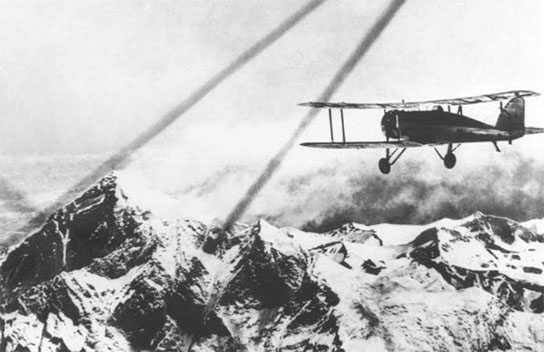
Clydesdale approaching the summit
The summit and last section of the northeast ridge 7
After the war the political situation in the region changed. The Chinese closed Tibet to foreigners and Nepal opened. The 1950 an Anglo-American reconnaissance of Nepal, led by Charles Houston and Bill Tilman, and the 1951 British expedition, led by Eric Shipton, surveyed the Khumbu Solo region and identified a possible route to Everest via the South Col. The accounts of these expeditions provided the first images of Everest from the South.
Detail, Panorama from the shoulder of Pumori 8
To the dismay of the British, the 1952 expedition permit was awarded to the Swiss under the direction of Edouard Wyss-Dunant. Using Shipton’s 1951 reconnaissance, they came within 1000 ft of the summit and provided the panorama above.
The 1953 British expedition, led by John Hunt, totalled over 400 people, including 20 Sherpas. By the morning of 28 May it had come down to just two – Edmund Hillary and Tenzing Norgay.
Norgay (left) and Hillary climbing to camp IV, 27 May 1953
The pair left camp IX on the South Col at 6:30 am (NPT) and after five hours of climbing Hillary recounted:
“...I then realised that the ridge ahead, instead of still monotonously rising, now dropped sharply away... I looked upwards to see a narow snow ridge running up to a snowy summit. A few more whacks of the ice-axe in the firm snow, and we stood on the top.”
They spent perhaps 15 mins on the summit where Hillary took the iconic Kodachrome of Norgay:
Tenzing Norgay on top of the world. The most famous photo in mountaineering
Over the last 60 years thousands of people have climbed Everest and have taken countless thousands of pictures with everything from an iPhone to an IMAX camera to the ISS 800 mm camera. Considering the logistical hurdles, equipment limitations and difficult conditions at high altitude faced by the early expeditions, their photographic record was nothing short of remarkable. The seriousness of the early photographers was perhaps best summed up by by Noel who said: “to dabble fatuously in trivialities in face of Everest’s grandeur would be sacrilege.”
1. The 41½ × 8¾" panorama was included as a separate insert in Kurz, Marcel (ed). The Mountain World: Everest 1952. New York: Harper & Brothers, 1953. Your narrator bought this book solely because of the panorama – how could I not? For more photos from the 1952 SFAR expeditions see: Roch, André. Everest 1952. Genève: Editions Jeheber, 1952.
2. Kindly supplied to the expedition by the Imperial Dry-Plate Co., Ltd. Cricklewood, Lomdon:
3. The 1921 photos are from Howard-Bury, C.K. The Mount Everest Expedition. The Geographical Journal. 1922 Feb;59(2): 81–99, and were discussed in Howard-Bury, C.K. The Mount Everest Maps and Photographs Source. The Geographical Journal. 1922 Feb;59(2): 131–137.
4. From Finch, G.I. The Second High Climb. The Geographical Journal. 1922 Dec;60(6): 413–422.
5. Bruce, J. From The Journey Through Tibet and the Establishment of the High Camps. The Geographical Journal. 1924 Dec;64(6): 443–450.
6. The Kodak Vest Pocket camera was introduced in 1912 and became popular during WWI due to it’s small size and low cost. Noel supplied the climbers with a Vest Pocket Model B Autographic which used 127 film, capable of producing eight 1¾" × 2½" exposures. Everest historian Tom Holzel and Kodak researchers even supplied the expedition with detailed developing instructions should the camera be found. Here’s a photo of my Dad’s VPK Model B, which, as far as we can tell, was never on a mountain:
7. Ruttledge, Hugh. The Mount Everest Expedition. The Geographical Journal. 1934 Jan;83(1): 1–9.
8. Shipton, Eric. Everest: The 1951 Reconnaissance of the Southern Route. The Geographical Journal. 1952 Jun;118(2): 117–141.
9. As Hillary stated “I had carried my camera, loaded with colour film, inside my shirt to keep it warm, so I now produced it and got Tenzing to pose for me on the top, waving his ice-axe on which was a string of flags–British, Nepalese, United Nations, and Indian.” There are no photographs of Hillary’s ascent because as he later said: “Tenzing did not know how to use a camera and it was not the moment to teach him!” In his autobiography Norgay disputes this writing: “I motioned to Hillary that I would now take his picture. But for some reason he shook his head; he did not want it.”
22 Apr 2012 ‧ Photography
